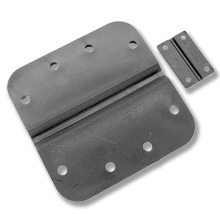
Do you know how hinge swaging works? When shopping for a new hinge, most people focus on the material, finish and style while overlooking the swage. As a result, they may end up with a poorly fitted hinge. By understanding the swaging process, however, you can avoid this headache while choosing the perfect hinge for your next project.
What Is Swaging?
Swaging, when used in the context of hinges, is the process of creating a gap between a hinge’s leafs when the hinge is in the closed position. It’s typically used for door hinges.
Door hinges feature two leafs and a pin-secured knuckle. The two leafs interlock together, thereby forming the knuckle. A long and narrow pin is placed through the knuckle to hold the leafs together. Swaging involves the manipulation of a hinge’s leafs so that that they are closer together when the hinge is closed.
How Swaging Works
Swaging is typically done by carefully bending the hinge’s leafs with a specialized tool. Either one or both of the hinge’s leafs are bent toward the hinge’s knuckle. This reduces the gap between the two leafs when the hinge is closed.
The term “swag” is used to describe the gap between a hinge’s two leafs when the hinge is closed. The term “swaging,” on the other hand” is used to describe the process of creating or narrowing this gap.
Common swaging options for hinges include the following:
- One leaf half-swaged
- Both leafs half-swaged
- One leaf full-swaged
- One leaf reverse-swaged
Keep in mind that hinges can also be designed with offset leafs. When offset, the leafs will provide more clearance. Offset leafs involve widening the gap between the hinge’s two leafs, whereas swaging involves reducing or narrowing the gap between the hinge’s two leafs.
Why Swaging Matters
If you’re looking to buy a door hinge, you should consider the swage. Overlooking this feature may result in a poor fit.
Doors should remain flush with the adjacent frame and jamb when closed. Some doors, though, may have a gap between them and the adjacent frame and jamb. Swaging prevents this from happening by ensuring a proper fit. Assuming the swage is the right size — swage sizes can vary — the door will fit right while remaining flush with the frame and jamb.
In Conclusion
Swaging isn’t something that most people think about when shopping for hinges; it’s only when they install a hinge and realize that it doesn’t fit that they acknowledge the importance of swaging.
